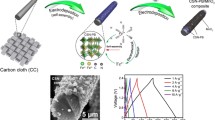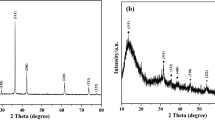Abstract
In this paper, we report a high-performance self-supported supercapacitor electrode composed of a cracked bark-shaped Ni-Co-Mn ternary metallic sulfide (NiCoMnS4) nanostructure on carbon cloth prepared by a simple one-step hydrothermal process and subsequent electrochemical treatment. The electrode delivers a high specific discharge capacity of up to 2470.4 F g−1 at 1 A g−1 and high rate performances of 1635.6 F g−1 at 10 A g−1 and 910.2 F g−1 even at 32 A g−1. Cycling tests indicate that NiCoMnS4 could maintain >91.1% of its initial capacity and nearly 100% Coulombic efficiency over 10,000 cycles at 8 A g−1. An aqueous asymmetric supercapacitor assembled with NiCoMnS4 as the cathode, activated carbon as the anode, and 1 mol L−1 KOH as the electrolyte delivers an energy density of 68.2 W h kg−1 at 850.1 W kg−1 and capacity retention of 92.5% after 10,000 cycles at 4 A g−1. Given the excellent performance and simple material preparation of our proposed device, this study provides a valuable foundation for the development of self-supported metallic sulfide based electrodes with high electrochemical properties for potential application in aqueous asymmetric supercapacitors.
摘要
本论文报道了一种高性能的自支撑超级电容器电极. 通过一 步水热工艺和随后的简单电化学处理, 在碳布上制备了具有开裂 树皮形状的镍-钴-锰三元金属硫化物(NiCoMnS4)纳米结构. 该电 极在1 A g−1电流密度下, 可实现高达2470.4 F g−1的比容量, 并展现 出良好的倍率性能和循环稳定性. 组装的基于活性炭//NiCoMnS4 构型的水系非对称超级电容器的电压窗口可达1.7 V; 在 850.1 W kg−1功率密度下, 获得了68.2 W h kg−1的能量密度; 在 4 A g−1电流密度下, 经过10,000次循环后, 容量保持率达92.5%. 该 电极材料制备方法简单且具有良好的储能性能, 因此本研究对开 发电化学性能良好的自支撑金属硫化物电极及相关高性能水系超 级电容器具有重要的参考价值.
Similar content being viewed by others
References
Miller JR, Simon P. Electrochemical capacitors for energy management. Science, 2008, 321: 651–652
Deng L, Li W, Li H, et al. A hierarchical copper oxide-germanium hybrid film for high areal capacity lithium ion batteries. Front Chem, 2019, 7: 869
Zhu J, Li Y, Yang B, et al. A dual carbon-based potassium dual ion battery with robust comprehensive performance. Small, 2018, 14: 1801836
Wang J, Wang X, Lee SW, et al. Enhanced performance of an electric double layer microsupercapacitor based on novel carbon-encapsulated Cu nanowire network structure as the electrode. ACS Appl Mater Interfaces, 2019, 11: 40481–40489
Yang J, Liu J, Zhao C, et al. Core-shell structured heterohierachical porous Si@graphene microsphere for high-performance lithiumion battery anodes. Mater Lett, 2020, 266: 127484
Zhu J, Xu Y, Fu Y, et al. Hybrid aqueous/nonaqueous water-in-bisalt electrolyte enables safe dual ion batteries. Small, 2020, 16: 1905838
Han C, Zhu J, Zhi C, et al. The rise of aqueous rechargeable batteries with organic electrode materials. J Mater Chem A, 2020, 8: 15479–15512
Simon P, Gogotsi Y. Materials for electrochemical capacitors. Nat Mater, 2008, 7: 845–854
Li M, Lu J, Chen Z, et al. 30 years of lithium-ion batteries. Adv Mater, 2018, 30: 1800561
Jia L, Li Y, Su L, et al. TiO2 nanoparticles in situ formed on Ti3C2 nanosheets by a one-step ethanol-thermal method for enhanced reversible lithium-ion storage. ChemistrySelect, 2020, 5: 3124–3129
Tang Y, Chen T, Yu S, et al. A highly electronic conductive cobalt nickel sulphide dendrite/quasi-spherical nanocomposite for a supercapacitor electrode with ultrahigh areal specific capacitance. J Power Sources, 2015, 295: 314–322
Ding Y, Yang B, Chen J, et al. Nanotube-like hard carbon as highperformance anode material for sodium ion hybrid capacitors. Sci China Mater, 2018, 61: 285–295
Wang C, Xu J, Yuen MF, et al. Hierarchical composite electrodes of nickel oxide nanoflake 3D graphene for high-performance pseudocapacitors. Adv Funct Mater, 2015, 24: 6372–6380
Liu H, Zhang Y, Dong J, et al. Curving effects of concave dode-cahedral nanocarbons enable enhanced Li-ion storage. J Mater Chem A, 2018, 6: 14894–14902
Guo H, Liu L, Dou Q, et al. Punching holes on paper-like electrodes: An effective strategy to enhance rate performance of supercapacitors. Energy Storage Mater, 2019, 19: 338–345
Wang J, Tian L, Xie W, et al. A hierarchical interconnected nanosheet structure of porous δ-MnO2 on graphite paper as cathode with a broad potential window for NaNO3 aqueous electrolyte supercapacitors. ACS Appl Energy Mater, 2020, 3: 2614–2622
Tang Y, Chen S, Mu S, et al. Synthesis of capsule-like porous hollow nanonickel cobalt sulfides via cation exchange based on the kirkendall effect for high-performance supercapacitors. ACS Appl Mater Interfaces, 2016, 8: 9721–9732
Sivakumar P, Jana M, Jung MG, et al. Hexagonal plate-like Ni-Co-Mn hydroxide nanostructures to achieve high energy density of hybrid supercapacitors. J Mater Chem A, 2019, 7: 11362–11369
Meng A, Shen T, Huang T, et al. NiCoSe2/Ni3Se2 lamella arrays grown on N-doped graphene nanotubes with ultrahigh-rate capability and long-term cycling for asymmetric supercapacitor. Sci China Mater, 2020, 63: 229–239
Han X, Tao K, Wang D, et al. Design of a porous cobalt sulfide nanosheet array on Ni foam from zeolitic imidazolate frameworks as an advanced electrode for supercapacitors. Nanoscale, 2018, 10: 2735–2741
Yao T, Guo X, Qin S, et al. Effect of rGO coating on interconnected Co3O4 nanosheets and improved supercapacitive behavior of Co3O4/rGO/NF architecture. Nano-Micro Lett, 2017, 9: 38
Ding Y, Li Y, Li J, et al. High-performance nitrogen and sulfur co-doped nanotube-like carbon anodes for sodium ion hybrid capacitors. Chin Chem Lett, 2020, 31: 2219–2224
Chen J, Yang B, Li H, et al. Candle soot: onion-like carbon, an advanced anode material for a potassium-ion hybrid capacitor. J Mater Chem A, 2019, 7: 9247–9252
Annamalai KP, Liu L, Tao Y. Highly exposed nickel cobalt sulfide-rGO nanoporous structures: an advanced energy-storage electrode material. J Mater Chem A, 2017, 5: 9991–9997
Long X, Tian L, Wang J, et al. Interconnected δ-MnO2 nanosheets anchored on activated carbon cloth as flexible electrode for highperformance aqueous asymmetric supercapacitors. J Electroanal Chem, 2020, 877: 114656
Guo Y, Yang J, Wu D, et al. Au nanoparticle-embedded, nitrogen-deficient hollow mesoporous carbon nitride spheres for nitrogen photofixation. J Mater Chem A, 2020, 8: 16218–16231
Yao T, Li Y, Liu D, et al. High-performance free-standing capacitor electrodes of multilayered Co9S8 plates wrapped by carbonized poly (3,4-ethylenedioxythiophene):poly(styrene sulfonate)/reduced graphene oxide. J Power Sources, 2018, 379: 167–173
Sahoo S, Mondal R, Late DJ, et al. Electrodeposited nickel cobalt manganese based mixed sulfide nanosheets for high performance supercapacitor application. Microporous Mesoporous Mater, 2017, 244: 101–108
Sanchez JS, Pendashteh A, Palma J, et al. Insights into charge storage and electroactivation of mixed metal sulfides in alkaline media: NiCoMn ternary metal sulfide nano-needles forming core-shell structures for hybrid energy storage. J Mater Chem A, 2019, 7: 20414–20424
Han X, Wang B, Yang C, et al. Inductive effect in Mn-doped NiO nanosheet arrays for enhanced capacitive and highly stable hybrid supercapacitor. ACS Appl Energy Mater, 2019, 2: 2072–2079
He W, Wang C, Li H, et al. Ultrathin and porous Ni3S2/CoNi2S4 3D-network structure for superhigh energy density asymmetric supercapacitors. Adv Energy Mater, 2017, 7: 1700983
Qin S, Yao T, Guo X, et al. MoS2/Ni3S4 composite nanosheets on interconnected carbon shells as an excellent supercapacitor electrode architecture for long term cycling at high current densities. Appl Surf Sci, 2018, 440: 741–747
Xu X, Liu W, Kim Y, et al. Nanostructured transition metal sulfides for lithium ion batteries: Progress and challenges. Nano Today, 2014, 9: 604–630
Chen W, Xia C, Alshareef HN. One-step electrodeposited nickel cobalt sulfide nanosheet arrays for high-performance asymmetric supercapacitors. ACS Nano, 2014, 8: 9531–9541
Meng G, Yang Q, Wu X, et al. Hierarchical mesoporous NiO nanoarrays with ultrahigh capacitance for aqueous hybrid supercapacitor. Nano Energy, 2016, 30: 831–839
Yang C, Wang X, Dong W, et al. Nitrogen-doped black titania for high performance supercapacitors. Sci China Mater, 2020, 63: 1227–1234
Wang D, Wu X, Wang Z, et al. Cracking causing cyclic instability of LiFePO4 cathode material. J Power Sources, 2005, 140: 125–128
Woodford WH, Chiang YM, Carter WC. “Electrochemical shock” of intercalation electrodes: a fracture mechanics analysis. J Electrochem Soc, 2010, 157: A1052
Pendashteh A, Sanchez JS, Palma J, et al. Anchored NiCoMnS4 nanoparticles on N-doped rGO: High-performance bifunctional electrocatalysts for rechargeable Zn-air batteries. Energy Storage Mater, 2019, 20: 216–224
Xia C, Li P, Gandi AN, et al. Is NiCo2S4 really a semiconductor? Chem Mater, 2015, 27: 6482–6485
Li Q, Li L, Owusu KA, et al. Self-adaptive mesoporous CoS @alveolus-like carbon yolk-shell microsphere for alkali cations storage. Nano Energy, 2017, 41: 109–116
Chen X, Shi T, Zhong K, et al. Capacitive behavior of MoS2 decorated with FeS2@carbon nanospheres. Chem Eng J, 2020, 379: 122240
You B, Wang L, Yao L, et al. Three dimensional N-doped graphene-CNT networks for supercapacitor. Chem Commun, 2013, 49: 5016–5018
Liu Y, Lu Q, Huang Z, et al. Electrodeposition of Ni-Co-S nanosheet arrays on N-doped porous carbon nanofibers for flexible asymmetric supercapacitors. J Alloys Compd, 2018, 762: 301–311
Xiong G, He P, Liu L, et al. Plasma-grown graphene petals templating Ni-Co-Mn hydroxide nanoneedles for high-rate and long-cycle-life pseudocapacitive electrodes. J Mater Chem A, 2015, 3: 22940–22948
Hua M, Cui F, Huang Y, et al. Crafting nanosheet-built MnCo2S4 disks on robust N-doped carbon matrix for hybrid supercapacitors. Electrochim Acta, 2019, 323: 134770
Chandra Sekhar S, Nagaraju G, Ramulu B, et al. Multifunctional core-shell-like nanoarchitectures for hybrid supercapacitors with high capacity and long-term cycling durability. Nano Res, 2019, 12: 2597–2608
Liu S, Jun SC. Hierarchical manganese cobalt sulfide core-shell nanostructures for high-performance asymmetric supercapacitors. J Power Sources, 2017, 342: 629–637
Gao F, Xu B, Wang Q, et al. Potentiostatic deposition of CoNi2S4 nanosheet arrays on nickel foam: effect of depostion time on the morphology and pseudocapacitive performance. J Mater Sci, 2016, 51: 10641–10651
Gao Z, Chen C, Chang J, et al. Enhanced cycleability of faradic CoNi2S4 electrode by reduced graphene oxide coating for efficient asymmetric supercapacitor. Electrochim Acta, 2018, 281: 394–404
Jing C, Guo X, Xia L, et al. Morphologically confined hybridization of tiny CoNi2S4 nanosheets into S, P co-doped graphene leading to enhanced pseudocapacitance and rate capability. Chem Eng J, 2020, 379: 122305
Acknowledgements
This work was supported by the National Natural Science Foundation of China (61376068, 11304132, 11304133 and 11504147), and the Fundamental Research Funds for the Central Universities (lzujbky-2017-178 and lzujbky-2017-181).
Author information
Authors and Affiliations
Contributions
Wang X and Tian L participated in the design of this study, and they both conducted the experiments, performed data analysis and drafted the manuscript. Long X participated in part of the experiments and collected important background information. Yang M, Song X and Xie W participated in literature search, data acquisition and analysis, and manuscript preparation. Liu D and Fu Y provided assistance for data acquisition and data analysis. Li J proposed the idea, supervised the research and revised the manuscript. Li Y supervised the research and revised the manuscript. He D performed manuscript review. All authors have read and approved the content of the manuscript.
Corresponding authors
Additional information
Conflict of interest
The authors declare no conflict of interest.
Xiao Wang is currently a master student at the School of Physical Science & Technology, Lanzhou University. Her research interest focuses on the development of novel metallic sulfide nanomaterials and the related high-performance aqueous supercapacitors.
Junshuai Li is currently a professor at the School of Physical Science & Technology, Lanzhou University. Prior to holding this position, he performed the research on preparation of high-quality PV materials and structures, design and fabrication of advanced Si nanostructure-based PV devices at Saitama University, Japan (2006.10–2008.09) and Nanyang Technological University, Singapore (2008.09–2012.03). Now his main research interest focuses on the optical and electrical behaviors in subwavelength semiconductor structures, and renewable energy devices.
Yali Li received her bachelor and master degrees of science both from Lanzhou University and doctor degree of engineering from Saitama University, Japan. From 2009.01 to 2012.03, she worked at Nanyang Technological University, Singapore as a research fellow. Now, she holds a faculty position at the School of Physical Science & Technology, Lanzhou University. Her current research focuses on energy-harvesting and storage devices.
Supporting Information
40843_2020_1562_MOESM1_ESM.pdf
Cracked bark-inspired ternary metallic sulfide (NiCoMnS4) nanostructure on carbon cloth for high-performance aqueous asymmetric supercapacitors
Rights and permissions
About this article
Cite this article
Wang, X., Tian, L., Long, X. et al. Cracked bark-inspired ternary metallic sulfide (NiCoMnS4) nanostructure on carbon cloth for high-performance aqueous asymmetric supercapacitors. Sci. China Mater. 64, 1632–1641 (2021). https://doi.org/10.1007/s40843-020-1562-1
Received:
Accepted:
Published:
Issue Date:
DOI: https://doi.org/10.1007/s40843-020-1562-1




